12 The Aboriginal and Torres Strait Islander Flags
What do the flags mean?
The Aboriginal and Torres Strait Islander flags are a pure and enduring symbol of Aboriginal and Torres Strait Islander peoples and their ongoing spiritual connection to the land.
Following wide acceptance of the flags in Australian society, the Governor General of Australia, William Hayden, proclaimed both Aboriginal and Torres Strait Islander flags to be ‘Flags of Australia’ on 14 July 1995.
Both flags have permanent positions on all three UQ campuses. At the St. Lucia campus, you’ll see the flags soaring on top of the Forgan Smith Building, as you drive up Sir Fred Schonell Drive. Nearby at Herston, you’ll see the flags flying in front of the Mayne Medical Building and at the main entrance of the Gatton campus. Try to spot these the next time you’re at any of the UQ campuses!
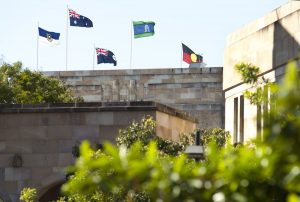
Aboriginal flag
The Aboriginal flag was designed by Harold Joseph Thomas, a Luritja man from Central Australia, to advocate for his people’s civil rights. It was first flown on National Aborigines’ Day on 12 July 1971 and then at the Tent Embassy in 1972.
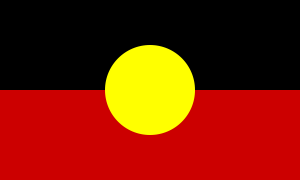
The flag’s design consists of equal halves of black and red with a yellow circle in its centre. The top of the flag is black and represents the Aboriginal people. The lower half of the flag is red and depicts the Earth and ochre, a precious resource that carries ceremonial significance. In the centre is the sun, the yellow circle, the constant giver of life. Together, these symbols denote the Aboriginal people’s deep-rooted relationship to the land, bound and sustained by the sun (Australian Institute of Aboriginal and Torres Strait Islander Studies).
Torres Strait Islander flag
Designed by the late Bernard Namok from Thursday Island in 1992, the Torres Strait Islander flag symbolises the unity and identity of all Torres Strait Islanders.
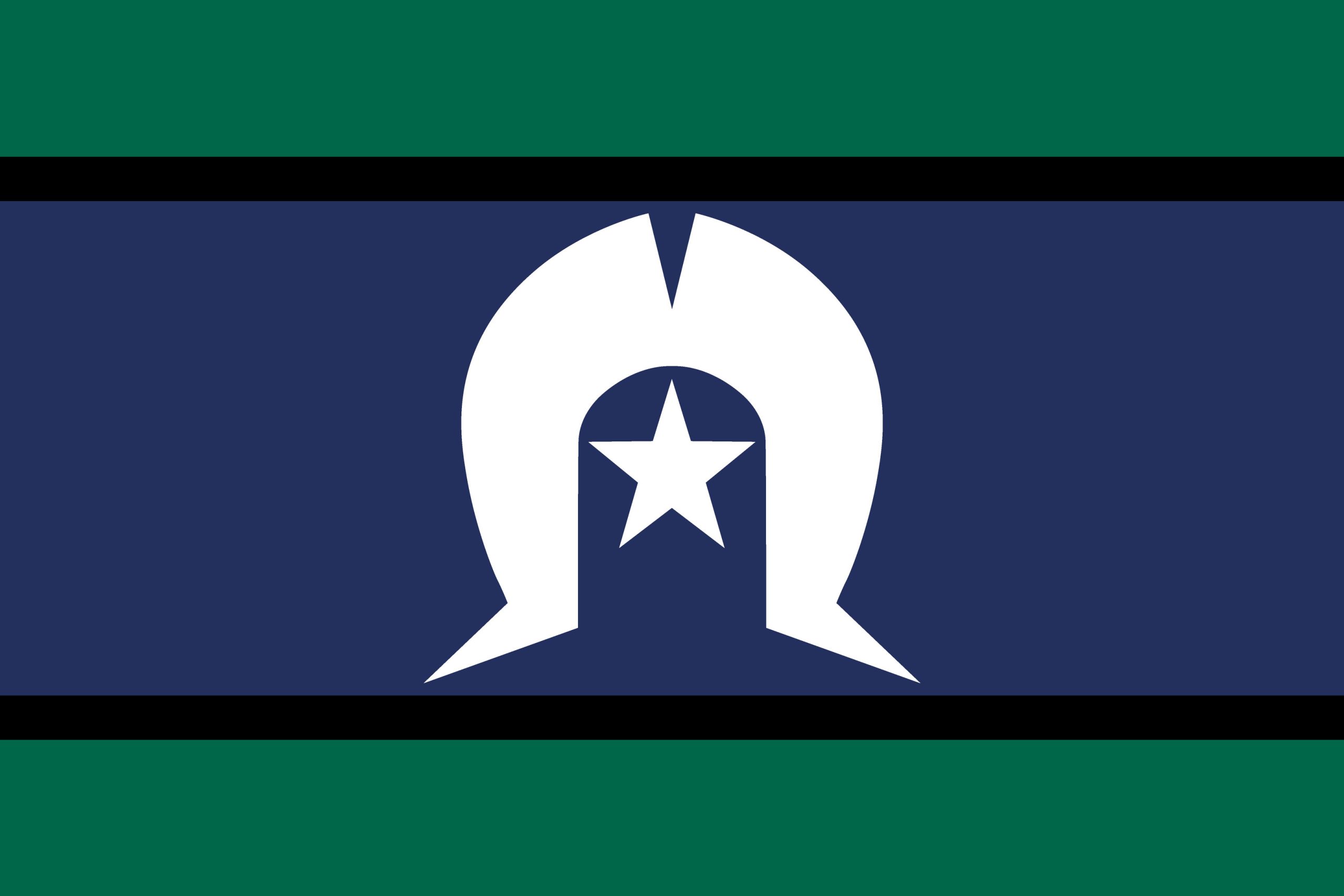
The Torres Strait Islander flag’s design shows the colours green, black and blue in its backdrop, and in its centre is a white dhari* (a type of dancer’s headdress and a pertinent symbol of the Torres Strait) and a white five-pointed star (Torres Strait Regional Authority).
The green represents the land while the large span of blue symbolises the sea. The black lines dividing the two colours depict the Torres Strait Islander people. The dhari in the centre symbolises the identity and unity of Torres Strait Islanders and their culture. The dhari is usually worn at night by males for performances (the dhari’s movement during the dance has been described famously as “a pearl shell dropped in water”). The dhari is traditionally made with Frigate Bird and Torres Strait Pigeon feathers (Queensland Museum Network 1988). The white five-pointed star represents the five island groups (for sea-faring Torres Strait Islander people, the star is a symbol of navigation and direction), while the white colour of the star refers to peace.
* Spelling varies between the islands. For example, in the Western Islands, where Kala Lagaw Ya is spoken, the headdress is called Dhoeri. The design and its use may also vary slightly (Queensland Museum Network 1988).
Why is flying the flags important?
Flying the flags is a visible representation of respect. The flags are flown on significant dates and during significant weeks including NAIDOC Week (the first week in July) and National Reconciliation Week (27 May – 3 June) to celebrate, respect, and promote greater understanding of Aboriginal and Torres strait Islander peoples and culture.
Raising the flags showcases commitment towards and recognition of Reconciliation, and creates a more welcoming and inclusive community for Aboriginal and Torres Strait Islander peoples.
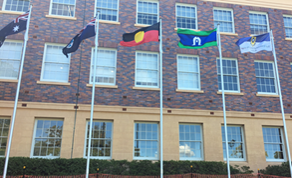
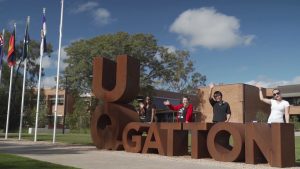
What are the protocols for raising and lowering the flags?
The Aboriginal and Torres Strait Islander flags are flown in conjunction with the Australian flag. The flags should be flown upright with the Aboriginal flag to the left of the Torres Strait Islander flag. The Aboriginal flag must always have the black half upward to the sky and the red half downwards. The Torres Strait Islander flag is upright when the Dhari appears like a downward horse-shoe. If required to be hung in portrait rather than landscape position, then the top of the flag is to the left.
It is respecful to acknowledge when an Elder or Valued Person passes away. The flags are lowered to the half-mast position as a sign of mourning. The half-mast position is when the top of the flag is approximately one-third of the distance down from the top of the mast. With the passing of Elders and/or Valued Members of the Aboriginal and Torres Strait Islander Community, the flags remain in the half-mast position until the funeral of the Elder and/or Valued Member has occurred.
What about copyright?
In 2022, the Australian Government secured the copyright licence for the Aboriginal Flag, following negotiations with flag designer, Harold Thomas. Use of the Aboriginal flag will now follow the same protocols as for the Australian National Flag, where its use is free, but it must be treated with respect and dignity. The Aboriginal flag can be used on UQ websites and social media sites where appropriate, but not in email signatures.
However, Carroll & Richardson Flagworld still holds an exclusive licence to reproduce or authorise the reproduction of the design of the Aboriginal flag on flags, pennants, banners and bunting and to manufacture, promote, advertise, distribute and sell those products throughout the world.
The Torres Strait Islander flag is also under copyright licence. Permission to use the Torres Strait Islander flag is obtained in writing by approaching the Torres Strait Island Regional Council, subject to the following conditions:
- where appropriate, recognition is given to the original designer, the late Mr Bernard Namok
- original PMS colours are used
- permission must be received in writing from the Council prior to its use.
Do you remember the ‘Free the Flag’ and #PridenotProfit campaign?
Prior to the Australian Government securing copyright of the Aboriginal flag on 25 January 2022, the world-wide exclusive license to reproduce the flag on clothing was owned by a non-Indigenous company. The company issued cease and desist notices to companies including Clothing the Gap, Aboriginal Health Services, the AFL (which uses the flag on club jerseys for its Indigenous round) and Spark Health, an Indigenous social enterprise. The national campaign sparked wide support to stop the non-Indigenous company having the exclusive license, as Aboriginal and Torres Strait Islander people were joined by non-Indigenous people to ‘free the flag’.
Was the Commonwealth Government securing the copyright an appropriate solution? Some agree, some are unsure, while others disagree. Read this article – Don’t say the Aboriginal flag was ‘freed’ – it belongs to us, not the Commonwealth – by Professor Bronwyn Carlson (2022) to understand a range of views on ‘freeing’ the flag.

